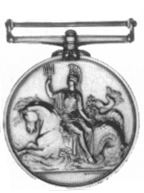Naval General Service Medal (1847)
| Naval General Service Medal | |
|---|---|
  Obverse (top left) and reverse (top right) of the medal. Ribbon: 32mm, white with dark blue edges.
|
|
| Awarded by United Kingdom of Great Britain and Ireland | |
| Type | Campaign medal |
| Eligibility | Royal Navy |
| Awarded for | Campaign service |
| Campaign(s) | Naval Actions 1793–1840 |
| Description | Silver disk, 36mm diameter |
| Clasps | 231 authorised, not all issued |
| Statistics | |
| Established | 1847 |
| Total awarded | 20,933 |
The Naval General Service Medal (NGSM) was a campaign medal approved in 1847, for issue to officers and men of the Royal Navy. (A handful of awards were made to officers and men of the British Army, present on board HM's ships at qualifying actions.)William Wyon was the designer. Admiral Thomas Bladen Capel was one of the members of the board that authorized the medal.
The NGSM was retrospectively awarded for various naval actions during the period 1793–1840, a period including the French Revolutionary Wars, the Napoleonic Wars, and the Anglo-American War of 1812. Each battle or action covered by the medal was represented by a clasp on the ribbon. The medal was never issued without a clasp, 231 of which were sanctioned. The clasps covered a variety of actions, from boat service to ship to ship skirmishes all the way to major fleet actions such as the Battle of Trafalgar.
Sir John Hindmarsh and Admiral of the Fleet Sir James Alexander Gordon were awarded medals with seven clasps, the most awarded to any individual. Four men qualified for six clasps, and fourteen men qualified for five clasps.
A point to note is that the medal was only awarded to surviving claimants; one had both to have survived until 1847 and then to actively apply for it. A combination of factors, from general illiteracy to limited publicity for the new medal meant that very many did not. There are substantially fewer medals issued when compared with the number of men who served during this period; frequently the number of claimants for individual clasps was reckoned in single figures—for ten clasps, there were no claimants. The Admiralty awarded 20,933 medals in total—most with a single clasp.
The final date for submitting claims was 1 May 1851. The medal was awarded only to surviving claimants; next of kin could not apply for a medal on behalf of a deceased relative. However, the medal was awarded to next of kin of those claimants who had died between the date of their application and the date of presentation.
...
Wikipedia
